
Wall-mounted shelves save floor space and provide a sleek, modern look by attaching directly to the wall, making them ideal for small rooms or minimalist decor. Discover how choosing between these options can transform your space by reading the full article.
Table of Comparison
| Feature | Wall-Mounted Shelf | Freestanding Shelf |
|---|---|---|
| Installation | Requires drilling, fixed to wall | No installation, easy to move |
| Space Saving | Maximizes floor space | Occupies floor space |
| Weight Capacity | Usually higher if properly anchored | Varies, depends on design |
| Flexibility | Fixed position | Portable and easy to reposition |
| Design Variety | Limited to wall size and structure | Wide variety of shapes and sizes |
| Installation Tools | Drill, screws, wall anchors | None required |
| Damage to Walls | Possible, due to mounting | None |
| Best Use | Permanent storage, minimal floor space | Temporary setups, versatile spaces |
Introduction to Wall-Mounted and Freestanding Shelves
Wall-mounted shelves provide space-saving storage by attaching directly to walls, ideal for maximizing floor area in small rooms. Freestanding shelves offer versatile placement options without installation, allowing easy repositioning and customization. Both shelf types balance functionality and style, catering to diverse organizational needs in residential and commercial spaces.
Key Features of Wall-Mounted Shelves
Wall-mounted shelves maximize floor space by attaching directly to walls, offering a sleek and modern aesthetic ideal for small rooms and minimalistic designs. They provide customizable height options and support various storage needs, from displaying decor to organizing books or kitchenware. Their installation requires secure mounting hardware to ensure stability and weight capacity, making them a durable and space-efficient storage solution.
Key Features of Freestanding Shelves
Freestanding shelves offer versatile storage solutions with easy relocation and no wall installation required, making them ideal for renters or frequent rearrangers. These shelves often come with adjustable height options and multiple tiers to accommodate various item sizes, enhancing organizational flexibility. You can maximize storage space while keeping your room layout adaptable with freestanding shelves designed to support heavy loads without compromising stability.
Space-Saving Benefits Compared
Wall-mounted shelves maximize space by utilizing vertical wall areas, freeing up valuable floor space in small rooms or apartments. Freestanding shelves offer flexibility in placement but occupy floor space, which may limit movement and reduce usable area in compact environments. Choosing wall-mounted options enhances room openness and optimizes storage in limited spaces.
Installation and Assembly Differences
Wall-mounted shelves require secure anchoring into studs or drywall using brackets, screws, and sometimes anchors, demanding precise measurement and drilling skills for safe installation. Freestanding shelves involve minimal assembly, often consisting of pre-drilled parts joined by screws or bolts, and can be easily relocated without wall damage. Installation of wall-mounted units provides space-saving benefits but requires durability considerations in load-bearing, while freestanding models prioritize flexibility and straightforward setup.
Durability and Weight Capacity
Wall-mounted shelves typically offer greater durability and higher weight capacity due to secure attachment to wall studs, making them ideal for heavy items like books or kitchenware. Freestanding shelves, while versatile and portable, often have lower weight limits and may wobble under heavy loads unless reinforced. Choose wall-mounted shelves if you need dependable strength and long-term stability for your storage needs.
Design Versatility and Aesthetics
Wall-mounted shelves offer sleek, space-saving design versatility ideal for minimalist and modern aesthetics, seamlessly blending into your walls without occupying floor space. Freestanding shelves provide flexible placement options and can serve as statement pieces or room dividers, enhancing the visual appeal of diverse interior styles. Your choice depends on whether you prioritize a streamlined look with wall-mounted units or dynamic, movable storage with freestanding options.
Safety and Stability Considerations
Wall-mounted shelves provide enhanced stability by securely anchoring to studs in the wall, reducing the risk of tipping or falling, which makes them safer in homes with children or pets. Freestanding shelves must have a sturdy base and may require anti-tip brackets to prevent accidental tipping, especially when placed in high-traffic areas. Proper installation and weight distribution are critical for both types of shelves to ensure long-term safety and stability.
Ideal Use Cases and Room Applications
Wall-mounted shelves are ideal for maximizing vertical space in small rooms, bathrooms, and kitchens, offering a sleek storage solution without occupying floor area. Freestanding shelves provide versatile, movable storage options suitable for living rooms, offices, and bedrooms where flexibility and customization are preferred. Both types cater to different spatial needs, with wall-mounted units optimizing compact areas and freestanding units enhancing adaptability in larger, open spaces.
Cost Analysis: Wall-Mounted vs Freestanding Shelves
Wall-mounted shelves typically have lower material costs but may require professional installation, increasing overall expenses, while freestanding shelves often come as ready-to-assemble units with varied price ranges based on size and material. Your choice impacts long-term value since wall-mounted options save floor space but might need sturdier wall support, potentially adding costs. Freestanding shelves offer flexibility in placement without installation fees but can occupy valuable floor area, influencing both cost and spatial efficiency.
 homyna.com
homyna.com